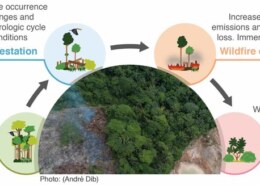Roadmap for Answer Writing 1. Introduction Briefly introduce the importance of tropical rainforests in maintaining global biodiversity and their role in regulating the Earth’s climate. Mention that these forests are increasingly under threat due to climate change, affecting both the environment and local ...
Deforestation occurs when forests are converted to non-forest uses, such as agriculture and road construction. It leads to the long-term loss of forest area. In contrast, forest degradation doesn’t reduce the forest area but rather results in a qualitative decline in forest condition. Forest ecosystRead more
Deforestation occurs when forests are converted to non-forest uses, such as agriculture and road construction. It leads to the long-term loss of forest area. In contrast, forest degradation doesn’t reduce the forest area but rather results in a qualitative decline in forest condition. Forest ecosystems lose their capacity to provide essential goods and services to people and nature during degradation. These threats jeopardize the critical role forests play in purifying water, mitigating climate change, and supporting biodiversity.
Local Impacts:
- Loss of Biodiversity: Deforestation disrupts habitats, leading to the loss of plant and animal species. Many species rely on specific forest ecosystems for survival.
- Changes in Water Cycle: Healthy forests play a vital role in the local water cycle by creating rainfall. When deforestation occurs, forests are less capable of fulfilling this role, resulting in changes in precipitation and river flow1.
- Soil Erosion: Tree roots stabilize soil, preventing erosion. Without trees, soil becomes vulnerable to erosion, affecting local agriculture and water quality.
- Temperature and Rainfall Changes: Deforestation, especially in tropical regions, impacts local temperatures and rainfall. These changes can compound the effects of global climate change, affecting human health and agricultural productivity.
Global Impacts
- Climate Change: Almost 17.4% of global greenhouse gas emissions result from deforestation and forest degradation. Trees store carbon, and excessive deforestation releases this carbon into the atmosphere, contributing to global warming and climate change.
- Carbon Sink Loss: Forests act as carbon sinks, absorbing carbon dioxide. Deforestation reduces this capacity, exacerbating climate change.
- Altered Weather Patterns: Deforestation affects weather patterns globally, impacting rainfall distribution and temperature regulation.
- Loss of Ecosystem Services: Forests provide essential services like air and water purification, nutrient cycling, and pollination. Their loss affects global ecosystems and human well-being.
Governments can provide policies and regulations that promote sustainable forestry practices and penalize companies that engage in deforestation.Efforts to combat deforestation include responsible forest management, reforestation, and sustainable land use practices. Protecting forests is crucial for a healthy planet and the well-being of all living beings.
See less

Model Answer 1. Landscape Transformation Climate change is threatening to transform tropical rainforests into dry savannas. Studies by Brazil's National Space Research Institute show that warmer and drier conditions could convert 30% to 60% of the Amazon rainforest into a dry savanna, resulting in aRead more
Model Answer
1. Landscape Transformation
Climate change is threatening to transform tropical rainforests into dry savannas. Studies by Brazil’s National Space Research Institute show that warmer and drier conditions could convert 30% to 60% of the Amazon rainforest into a dry savanna, resulting in a drastic loss of biodiversity.
2. Increased Forest Fires
Rising temperatures and reduced rainfall are leading to more frequent and intense forest fires. In 2019, the Amazon experienced catastrophic fires, pushing the rainforest closer to an irreversible tipping point. These fires are exacerbating deforestation and forest degradation.
3. Threatened Species
As the rainforest ecosystem deteriorates, biodiversity is severely impacted. For instance, scientists predict that by 2050, 33% of the species in the Western Ghats will be lost due to climate change, as many species are forced to migrate to higher altitudes for survival.
4. Altered Plant Phenology
Climate change is disrupting the natural cycles of tropical plants, such as early or late fruiting, which impacts species that depend on these plants, including pollinators like bees and hummingbirds. This disruption threatens the entire food chain in rainforests.
5. Food Shortages
The impact of climate change on agricultural productivity in tropical rainforest regions affects 1.2 billion people who depend on these forests for food and livelihood. This leads to food insecurity and economic instability for local communities.
Measures to Protect Tropical Rainforests
1. Conservation Efforts
Establishing protected areas and national parks is crucial to conserving tropical rainforests. These measures help preserve biodiversity and ensure sustainable land use while protecting ecosystems from deforestation.
2. Empowering Indigenous Knowledge
Indigenous communities possess traditional knowledge that can significantly contribute to rainforest conservation. For example, the Soliga tribe in the Western Ghats has used agroforestry and sustainable forest management practices to preserve biodiversity for centuries.
3. Promoting Payment for Ecosystem Services (PES)
The PES model rewards local communities for their role in environmental stewardship. Costa Rica’s PES program has helped reduce deforestation and increase forest cover to 54%, demonstrating the effectiveness of this approach.
4. Technological Innovations
Innovative tools like Firecast, which uses satellite technology to detect forest fires, are essential in early fire detection. These systems can help minimize the impact of forest fires on tropical rainforests by enabling rapid response and intervention.
Addressing the challenges of climate change in tropical rainforests requires a comprehensive approach combining conservation, indigenous knowledge, economic incentives, and technology.
See less